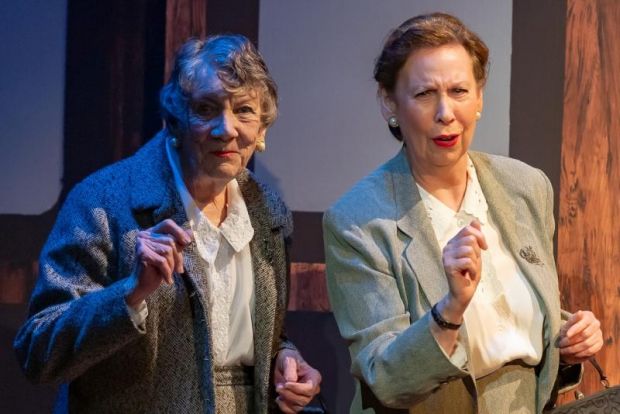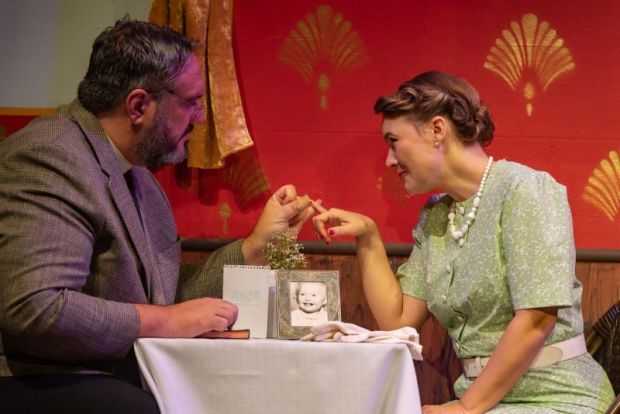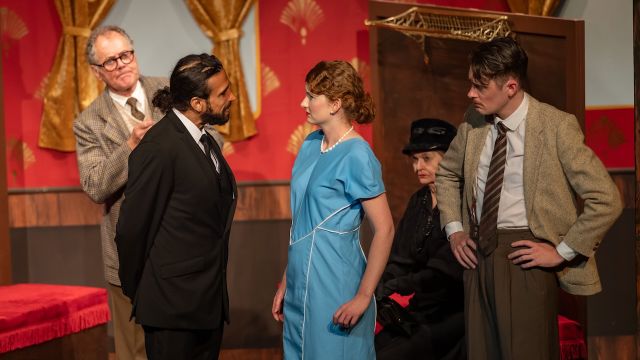The Lady Vanishes
Unlike Alfred Hitchcock’s 1938 movie adaptation, playwright Derek White goes back to the original novel by Ethel Lina White published in 1936 – and sticks as closely as possible to the story and the characters White created.
The play opens on a railway station. Among the passengers waiting for the train is a young woman, Iris Carr, who faints from sunstroke. Once on board the train she is befriended by Miss Froy, a governess who is travelling back to England in between positions in Moldavia. In the dining car Miss Froy talks openly in front of the Waiter about her wealthy, political previous employer.
They return to their compartment and Iris falls asleep. When she wakes, Miss Froy is missing and other passengers in the carriage – a Countess, a doctor, and an apparently honeymooning couple – deny Miss Froy’s existence.

Thus begins Iris’s search for Miss Froy, with the help of a young man called Max, who believes her story. Things become more and more complicated, and Max becomes more and more attracted to Iris. Eventually Iris almost believes that she is mistaken …
The complications in the plot are typical of mid-twentieth century mysteries, but Derek Webb has found some comedy in the genre and peopled his adaptation with stereotyped English travellers abroad and sinister ‘foreign’ villains dressed in black! But the play is still set on a railway station, and two different compartments on a train! Easy in a movie, but not so easy on the stage!
Emily Saint Smith envisioned a set with a sliding door. “Little did I realise,” she writes, “how complex I had made things … for the set builders and decorators, the stage manager, the bio box operators and … the actors.” And in the long run for herself and the audience, because the sliding doors became another weighty character in the play.

They are high and heavy. They have to be closed and opened between every carriage and dining car scene, and the furniture on the set behind them has to be changed. Though there are some scenes in the corridor, and some stage business as passengers push past each other, the scene changes are relatively long.
Congratulations to Peter Curtis and those who assisted with set construction. The logistics must have been a nightmare!
The cast of thirteen, in 1930s era costumes designed by long standing costume designer Susan Carveth, who also plays the Baroness, play an array of characters, all British except the Baroness, an evil-looking Doctor (Gabriel Jab’bar) and a clumsy and suspicious-looking Waiter played by Anastasia Vokhmyakova.

Joss Chalmers plays Iris Carr, a socialite looking for the next bit of fun. Chalmers makes her open, outspoken, confident – even when she feels she is being hoodwinked. Jono Lukins is Max Hare, the young Englishman who realises that Iris’s story could have some substance.
Their characters become stronger as they discuss possible scenarios in the second act.
Miss Froy is played by Penny Day. In an elegant swing jacket and purple-feathered hat, Day finds the accent and attitude of an educated English lady abroad – and her clear account of her last night at her former job is an important moment in the play.

Other passengers feed into the intrigue that is overwhelming Iris. The “Todhunters” (Liminka Pather and Billy Allagiannis), who are posing as a married couple; befuddled Reverend Barnes and his voluble wife (Ben Pobjie and Brooke Ryan); and the opiniated Professor (Ron Ringer).
There is also the Flood-Porter sisters, Evelyn and Rose played by Lynn Roise and Sandra Bass. It is nice to see these two very experienced actors playing together. Both found the verisimilitude of the two sisters and sustained it in every moment they were on the stage, whether in conversation, watching the action or appearing totally lost in the corridor! Bass’s comic timing was just perfect.

This is a difficult play for a first-time director, as Saint Smith admits in her program note. A big cast, an ambitious set, and dialogue and characters that are definitely of the 1930s. This requires practice and pace. That pace was missing on opening night – but should come as the run proceeds.
Carol Wimmer
Images: Anthony Burns, Homepix Photography P/L.
Subscribe to our E-Newsletter, buy our latest print edition or find a Performing Arts book at Book Nook.

